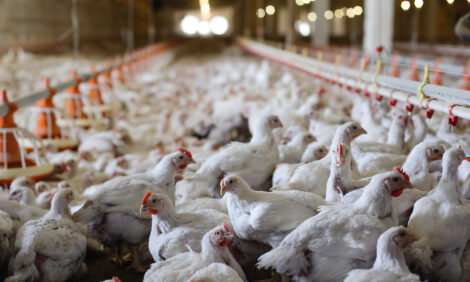



Interaction Effects between Sender and Receiver Processes in Transmission of Campylobacter
Dutch research has revealed that acidification of the drinking water can reduce the transmission of C. jejuni between birds. The treatment is equally effective when applied to the sender or receiver groups but there was a significant negative interaction when both groups received acidified water.Infectious diseases in plants, animals and humans are often transmitted indirectly between hosts (or between groups of hosts), i.e. via some route through the environment instead of via direct contacts between these hosts. In BMC Veterinary Research, Bram van Bunnik of the Central Veterinary Institute of Wageningen UR in the Netherlands and co-authors at Wageningen UR report their study of the indirect transmission experimentally, using transmission of Campylobacter jejuni between spatially separated broilers as a model system.
The group distinguished three stages in the process of indirect transmission: (1) an infectious 'sender' excretes the agent, after which (2) the agent is transported via some route to a susceptible 'receiver', and subsequently (3) the receiver becomes colonised by the agent. The role of the sender and receiver side (stage 1 and stage 3) was studied here by using acidification of the drinking water as a modulation mechanism.
In the experiment, one control group and three treatment groups were monitored for the presence of C. jejuni by taking daily cloacal swabs. The three treatments consisted of acidification of the drinking water of the inoculated animals (the senders), acidification of the drinking water of the susceptible animals (the receivers) or acidification of the drinking water of both inoculated and susceptible animals. In the control group, 12 animals got colonised out of a possible 40, in each treatment groups, three animals out of a possible 40 were found colonised with C. jejuni.
The results of the experiments show a significant decrease in transmission rate (beta) between the control group and treatments group (p<0.01 for all groups) but not between different treatments, concluded van Bunnik and co-authors. They found a significant negative interaction when both the sender and the receiver group receive acidified drinking water (p=0.01). This negative interaction effect could be due to selection of bacteria already at the sender side, thereby diminishing the effect of acidification at the receiver side.
Reference
van Bunnik B.A.D., T.J. Hagenaars, N.M. Bolder, G. Nodelijk and M.C.M. de Jong. 2012. Interaction effects between sender and receiver processes in indirect transmission of Campylobacter jejuni between broilers. BMC Veterinary Research, 8:123. doi:10.1186/1746-6148-8-123
Further ReadingYou can view the full report (as a provisional PDF) by clicking here. |
August 2012









